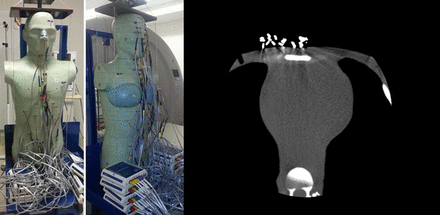JACC: Cardiovascular Imaging ( IF 12.8 ) Pub Date : 2018-01-01 , DOI: 10.1016/j.jcmg.2017.06.006 Sigal Trattner 1 , Sandra Halliburton 2 , Carla M Thompson 3 , Yanping Xu 4 , Anjali Chelliah 5 , Sachin R Jambawalikar 6 , Boyu Peng 6 , M Robert Peters 7 , Jill E Jacobs 8 , Munir Ghesani 9 , James J Jang 10 , Hussein Al-Khalidi 11 , Andrew J Einstein 12

|
Objectives This study sought to determine updated conversion factors (k-factors) that would enable accurate estimation of radiation effective dose (ED) for coronary computed tomography angiography (CTA) and calcium scoring performed on 12 contemporary scanner models and current clinical cardiac protocols and to compare these methods to the standard chest k-factor of 0.014 mSv·mGy−1cm−1.
Background Accurate estimation of ED from cardiac CT scans is essential to meaningfully compare the benefits and risks of different cardiac imaging strategies and optimize test and protocol selection. Presently, ED from cardiac CT is generally estimated by multiplying a scanner-reported parameter, the dose-length product, by a k-factor which was determined for noncardiac chest CT, using single-slice scanners and a superseded definition of ED.
Methods Metal-oxide-semiconductor field-effect transistor radiation detectors were positioned in organs of anthropomorphic phantoms, which were scanned using all cardiac protocols, 120 clinical protocols in total, on 12 CT scanners representing the spectrum of scanners from 5 manufacturers (GE, Hitachi, Philips, Siemens, Toshiba). Organ doses were determined for each protocol, and ED was calculated as defined in International Commission on Radiological Protection Publication 103. Effective doses and scanner-reported dose-length products were used to determine k-factors for each scanner model and protocol.
Results k-Factors averaged 0.026 mSv·mGy−1cm−1 (95% confidence interval: 0.0258 to 0.0266) and ranged between 0.020 and 0.035 mSv·mGy−1cm−1. The standard chest k-factor underestimates ED by an average of 46%, ranging from 30% to 60%, depending on scanner, mode, and tube potential. Factors were higher for prospective axial versus retrospective helical scan modes, calcium scoring versus coronary CTA, and higher (100 to 120 kV) versus lower (80 kV) tube potential and varied among scanner models (range of average k-factors: 0.0229 to 0.0277 mSv·mGy−1cm−1).
Conclusions Cardiac k-factors for all scanners and protocols are considerably higher than the k-factor currently used to estimate ED of cardiac CT studies, suggesting that radiation doses from cardiac CT have been significantly and systematically underestimated. Using cardiac-specific factors can more accurately inform the benefit-risk calculus of cardiac-imaging strategies.
中文翻译:

根据计算机断层扫描中的剂量长度乘积估算辐射有效剂量的心脏特定转换因子
目的本研究旨在确定更新的转换因子( k因子),以便能够准确估计冠状动脉计算机断层扫描血管造影 (CTA) 的辐射有效剂量 (ED) 和在 12 种当代扫描仪模型和当前临床心脏方案上进行的钙评分,并将这些方法与标准胸部k因子 0.014 mSv·mGy -1 cm -1进行比较。
背景通过心脏 CT 扫描准确估计 ED 对于有意义地比较不同心脏成像策略的益处和风险以及优化测试和方案选择至关重要。目前,心脏 CT 的 ED 通常是通过将扫描仪报告的参数(剂量长度乘积)乘以k因子来估计的,该 k 因子是使用单层扫描仪和 ED 的取代定义为非心脏胸部 CT 确定的。
方法 将金属氧化物半导体场效应晶体管辐射探测器放置在拟人模型的器官中,使用所有心脏协议(总共 120 个临床协议)在代表 5 个制造商(GE、Hitachi)扫描仪频谱的 12 台 CT 扫描仪上进行扫描。 、飞利浦、西门子、东芝)。确定每个方案的器官剂量,并按照国际放射防护委员会出版物 103 中的定义计算 ED。有效剂量和扫描仪报告的剂量长度乘积用于确定每个扫描仪型号和方案的k因子。
结果k因子平均为 0.026 mSv·mGy -1 cm -1 (95% 置信区间:0.0258 至 0.0266),范围在 0.020 至 0.035 mSv·mGy -1 cm -1之间。标准胸部k因子平均低估 ED 46%,范围从 30% 到 60%,具体取决于扫描仪、模式和管电位。前瞻性轴向扫描模式与回顾性螺旋扫描模式、钙评分与冠状动脉 CTA 相比、较高(100 至 120 kV)与较低(80 kV)管电位的因子较高,并且在扫描仪型号之间存在差异(平均k因子范围:0.0229 至 0.0277) mSv·mGy -1 cm -1 )。
结论所有扫描仪和方案的心脏k因子均远高于目前用于估计心脏 CT 研究 ED 的k因子,表明心脏 CT 的辐射剂量已被显着且系统性地低估。使用心脏特异性因素可以更准确地计算心脏成像策略的获益-风险。










































 京公网安备 11010802027423号
京公网安备 11010802027423号